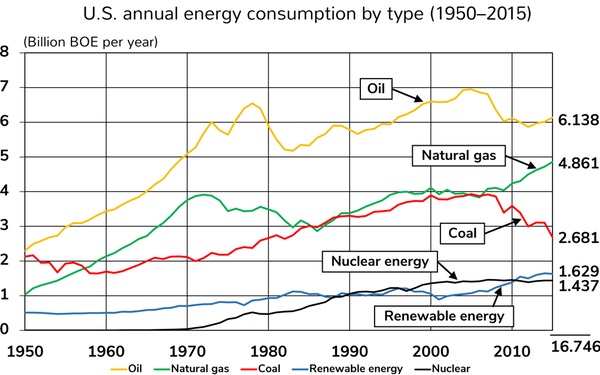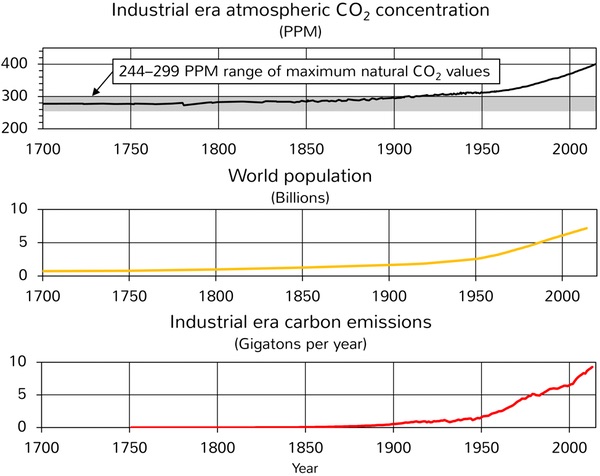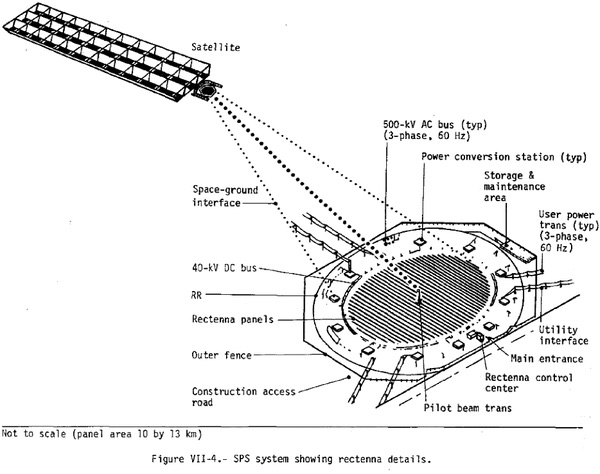Rationale for a national “astroelectricity” programby Mike Snead
|
| The need to peacefully end America’s fossil fuel energy insecurity is obvious. |
Where local wood fuel shortages developed, commercial coal mining began. Unavoidably, widely available coal replaced wood to become, by the 1880s, America’s primary fuel for industrial, transportation, and home use. Further technological advances brought kerosene lights and the internal combustion engine and their need for oil. As the last century began, America eagerly moved from coal to oil and natural gas, enjoying substantial economic prosperity and a rising standard of living as a result. Other industrializing nations saw comparable changes. Since the 1840s—for nearly 200 years—all of America’s economic progress has been achieved through non-sustainable energy.
 |
Today, fossil fuels provide about 80 percent of the energy consumed in America. Much of the public and most politicians take our fossil fuel supply for granted. They are unaware that America’s remaining technically recoverable oil and natural gas—which supply two-thirds of the energy Americans use—could be exhausted this century. This limited supply of domestic oil and natural gas is an existential threat to America’s prosperity and national security because there are no “off-the-shelf” domestic replacements. With no ready domestic replacements, military action will be needed to secure vital foreign oil and natural gas—a remedy that no reasonable American desires. The need to peacefully end America’s fossil fuel energy insecurity is obvious.
2. Why is fossil fuel carbon dioxide emission abatement needed?
Since the 1840s, America has been emitting carbon dioxide into the atmosphere from the combustion of non-sustainable fossil fuels as well as wood fuel consumed at a non-sustainable rate. Hence, throughout most of America’s history, substantial carbon fuel carbon dioxide emissions have been unavoidable due to America’s population growth and industrialization. The same is true for all industrialized nations.
Last century, scientists began to examine the impact of anthropogenic carbon dioxide emissions into the atmosphere. While many scientists focus on a possible symptom of the impact of these emissions on the environment—anthropogenic global warming—engineers are more likely to focus on what is readily measurable. This is the atmospheric carbon dioxide concentration.
 |
Using ice core samples covering the last 800,000 years, scientists have determined that the pre-industrial natural maximum carbon dioxide atmospheric concentration is around 300 parts per million (ppm) by volume. Around 1900, as the human population grew to about 1.6 billion, the carbon dioxide concentration climbed above the 300 ppm “natural” safe maximum. Today, with a population of nearly 8 billion, it is above 400 ppm and climbing each year.
Scientific investigation has determined, by measuring the variation in the proportion of different carbon isotopes in the atmospheric carbon dioxide over time, that anthropogenic fossil fuel carbon dioxide emissions are the primary cause of the elevated concentration. Being that these fossil fuel emissions are non-natural, the fossil fuel carbon dioxide emissions are a pollutant that we are now obligated to reduce and eliminate. This needs to be done in an orderly manner using new and available technologies and responsible environmental regulation.
While some argue that the increasing carbon dioxide concentration is having beneficial environmental effects—for example, visibly enhanced plant growth—environmental regulation must be based on tested hypotheses establishing what is safe; not on the perceived absence of harm. Regarding anthropogenic pollution, we cannot simply presume that no harm is being done. Instead, we must rely on rigorous scientific examination to determine what anthropogenic harm may exist and what level of anthropogenic harm is acceptably safe.
As of yet, there is no tested hypothesis that the abnormally high atmospheric carbon dioxide concentration is not harming the environment—especially living creatures. (Preliminary research suggests that the increasing carbon dioxide concentration is decreasing the nutritional value of plants used for food.) Consequently, moral, political, and/or legal actions will likely cause the federal government to take regulatory action to mitigate the environmental threat posed by America’s contribution to the excess anthropogenic atmospheric carbon dioxide concentration. It should be expected that: (1) fossil fuel carbon dioxide emissions into the atmosphere will end, and (2) the excess atmospheric carbon dioxide concentration will be abated by using technological means to return the concentration to the 300 ppm “natural” safe level.
3. What is a reasonable timeline for ending America’s fossil fuel use?
In 1992, under President George H. W. Bush, the United States became a party to the United Nations Framework Convention on Climate Change, a treaty establishing a moral obligation for the United States to address harm due to anthropogenic carbon dioxide emissions, particularly those from fossil fuels. In 2015, President Obama signed the treaty’s third attempt at an implementing protocol. This is called the Paris Climate Agreement. He did not submit the agreement to the US Senate for consent due to expected opposition. Surprisingly, the agreement does not even mention carbon dioxide or provide an engineering plan to address its potential harm. President Trump appropriately decided to withdraw the United States from the agreement due to its unfair, ineffective, and vague obligations, especially those placed on developed nations such as the United States.
| To an engineer, the appropriate path forward is not to try to second-guess nature, but to eliminate net carbon dioxide emissions by 2100 by ending fossil fuel use. |
Even though the United States will withdraw from the agreement, there is still the political argument that the United States, by virtue of the 1992 treaty, remains morally obligated to address potential harm from its fossil fuel emissions. A substantial fraction of American voters share this view. The agreement, using imprecise wording, states, “achieve a balance between anthropogenic emissions by sources and removals by sinks of greenhouse gases in the second half of this century on the basis of equity, and in the context of sustainable development and efforts to eradicate poverty.” (Emphasis added.) A reasonable interpretation is that the agreement’s intent is to end net anthropogenic carbon dioxide emissions by the end of the century.
To an engineer, the appropriate path forward is not to try to second-guess nature, but to eliminate net carbon dioxide emissions by 2100 by ending fossil fuel use. There is no other practical way to “achieve a balance between anthropogenic emissions by sources and removals by sinks.” Noting that the United States took about 80 years to transition from wood to fossil fuels, it is reasonable for the United States to adopt 2100 as the target date to end its fossil fuel carbon dioxide emissions. Setting such a target should quell concerns that the United States is not acting in good faith to be proactive, per the 1992 treaty, in addressing its anthropogenic emissions. Therefore, to end its fossil fuel emissions by 2100, the United States will need to have fully transitioned by 2100 from using “fossil” carbon fuels. However, this does not mean that the United States will necessarily abandon its use of all carbon fuels because synthetic carbon fuels will replace fossil carbon fuels.
4. What needs to be done to replace fossil fuels by 2100?
An engineering plan to transition the United States to 100 percent sustainable energy starts with defining what needs to be done. With an orderly transition from fossil carbon fuels to sustainable energy, sustainable electricity will become the primary source of energy. Sustainable electrical power, from nuclear and renewable sources, will be dispatched directly to end users just as electricity is transmitted to and distributed through local utilities today. However, most of the sustainable electrical power will be used to electrolyze hydrogen from water and to use hydrogen and carbon dioxide to produce synthetic carbon fuels. With this orderly transition from fossil carbon fuels, the only change will be that the carbon fuels Americans use will be synthesized rather than extracted from the Earth. Also, sustainable hydrogen will become generally available as an alternative industrial fuel. During and after transition, America’s economy will continue to function normally with America’s energy supply infrastructure operating much as it does today.
The use of the synthetic carbon fuels will, of course, emit carbon dioxide into the atmosphere. New industrial plants, powered by sustainable electrical power, will extract carbon dioxide from the atmosphere and use the carbon to make synthetic carbon fuels. This will prevent the carbon dioxide concentration from further increasing. Once the transition is completed by 2100, the output of these plants can be expanded to capture and convert additional carbon dioxide with the additional synthetic carbon fuels placed into permanent geologic storage. As this happens, the atmospheric carbon dioxide concentration will be reduced, eventually returning it to the pre-industrial level.
5. How much sustainable electricity generation capacity will be needed?
America’s population is expected to grow by about 50 percent to around 500 million by 2100. Most of this growth will be due to net international migration. The engineering plan to transition the United States to sustainable energy must take this expected growth into account.
America’s per capita energy use has been slowly declining since its peak in 1979 when the second oil crisis began. The decline is primarily due to improved energy efficiencies, such as improved car gas mileage and better building energy standards. By 2100, the per capita energy need may reasonably be expected to decline to a total of about 20 percent below the 1979 peak without sacrificing the middle class’s standard of living.
| Many now incorrectly believe that America can quickly transition from fossil fuels to sustainable energy. There is no “just get it done” solution to undertake this transition quickly. |
By 2100, the per capita energy need for a prosperous standard of living is expected to require about 10 kilowatts (kW) of continuous sustainable electrical power. (For perspective, an operating countertop microwave oven uses about 1 kilowatt of electrical power.) This would provide all immediate personal energy needs (i.e., household electricity, heating, fuel for driving, etc.) and the energy required to provide the goods and services used.
The total energy required in 2100 is the product of the total population size and the per capita energy need. 500 million Americans × 10 kW = 5 billion kW = 5,000 gigawatts (GW) of baseload sustainable electrical power generation capacity needed to meet all US energy needs in 2100. A little mental math shows that each gigawatt of baseload capacity will support 100,000 Americans.
Fossil fuels now provide about 80 percent of the total energy Americans consume. The remaining 20 percent is provided by terrestrial nuclear and renewables. Thus, to replace fossil fuels by 2100, 80% × 5,000 GW = 4,000 GW of new continuous electrical power generation capacity will be needed.
Many now incorrectly believe that America can quickly transition from fossil fuels to sustainable energy. For the current US population of 330 million, roughly 330 million × 12 kW × 80% = 3,168 GW of new sustainable electrical power generation capacity would be needed to replace fossil fuels. This equals about 1,500 Hoover Dams. Clearly, there is no “just get it done” solution to undertake this transition quickly.
6. What is the ballpark cost of this transition?
America’s gross domestic product (GDP) is now about $19 trillion, with about 10 percent spent on energy. For simplicity, by holding this GDP constant from 2020 through 2100, the total US GDP will be about $1,500 trillion with about $150 trillion spent on energy. A new nuclear power plant has a construction capital cost of around $5 billion per gigawatt. Building 5,000 gigawatts of sustainable generating capacity would cost (very roughly) $25 trillion over 80 years. (Each one million in population growth will require 10 gigawatts of added capacity costing about $50 billion in transition cost.) This is less than two percent of the total GDP from 2020 to 2100. Completing this transition by 2100 will provide sufficient time for this to be done without economic disruption while keeping the United States energy independent and secure. Obviously, further technological advances and/or a reduced population size in 2100 may enable an earlier completion year.
7. Why won’t terrestrial nuclear and renewables alone meet America’s needs?
Today, America has the equivalent of only about 170 gigawatts of continuous electrical power generation capacity provided by terrestrial nuclear and renewables. Pragmatically, most of any expansion will need to come from wind power, ground solar power, and terrestrial nuclear fission power, since there is only a limited ability to expand hydroelectric, geothermal electric, and biomass energy sources.
The potential to expand wind, ground solar, and nuclear power is quantitatively evaluated in my ebook Astroelectricity. Here are my findings:
- A large 1.6-megawatt wind turbine will yield enough wind electricity per year to meet the total annual energy needs of only about 50 Americans in 2100. Four of these turbines can be located per square mile, enabling the energy needs of only 200 Americans to be met per square mile of wind farm. To meet the energy needs of 50 million Americans would thus require 250,000 square miles of wind farms located on reasonably flat terrain. This would require using about eight percent of the contiguous United States to meet the energy needs of only 10 percent of its estimated 2100 population.
- Ground solar farms could meet the energy needs of about 1,600 Americans per square mile in 2100. To meet the energy needs of 50 million Americans with ground solar power would require about 32,000 square miles of solar farms on very flat terrain. Located in the southwestern United States due to the abundant insolation, these solar farms would need to use about 40 percent of the suitably flat land in Arizona, southern California, Colorado, Nevada, New Mexico, western Texas, and Utah. Again, this would only meet the energy needs of about 10 percent of the estimated 2100 population.
- A one-gigawatt nuclear power plant could meet the energy needs of about 100,000 Americans in 2100. It requires about 3,000 pounds of uranium 235, uranium 233, or plutonium per year. The United States currently has about 100 operating nuclear power plants, sufficient only to meet the needs of about 10 million Americans in 2100. Natural uranium fuel availability, permanent buried waste storage, adequate cooling water, locations avoiding populated areas or areas threatened by earthquakes and floods, and plant security are significant considerations limiting any significant expansion of nuclear fission energy in the United States. Breeding of fuel by the United States to yield uranium 233 or plutonium significantly increases the potential of nuclear weapons proliferation by hostile foreign nations also using breeding for their expanded use of nuclear energy. While it is likely that aging US nuclear power plants will be replaced, a significant expansion of nuclear fission energy is unlikely.
This preliminary assessment makes clear that continuing to provide 20 percent of America’s 2100 energy needs with terrestrial nuclear and renewables—enough for 100 million Americans—will be challenging. Supplying this primarily with expanded wind and ground solar power, along with replaced existing nuclear plants, would require around 250,000 square miles for wind and solar farms—about the area of Texas. Certainly, striving for terrestrials to supply a substantially greater percentage of America’s future energy supply is unrealistic. Thus, for America to properly solve its carbon dioxide environmental and fossil fuel energy insecurity threats, America has no other choice but to turn to geostationary orbit (GEO) space solar power, what I refer to as “astroelectricity.”
8. What is astroelectricity?
First proposed in 1968 and investigated in the 1970s and 1980s, space-based solar power places solar arrays in GEO on large orbiting platforms and transmits the electrical power produced to ground astroelectric plants. The baseline design has each astroelectric plant delivering five gigawatts of near-continuous, baseload electrical power. This baseload astroelectricity would replace coal and natural gas-fueled electrical power generation and would be used to produce hydrogen and synthetic carbon fuels to meet consumer, transportation, and industrial needs. Providing 80 percent—4,000 gigawatts—of the sustainable power America will need in 2100 will require 800 five-gigawatt ground astroelectric plants.
 |
Delivering astroelectricity is technically no different than how GEO broadcast satellites function. These satellites use solar arrays to produce the electrical power used to transmit the TV signal to the ground. GEO solar power platforms would do the same but, obviously, at a higher, but safe, power transmission level. Each astroelectricity plant will require about 63 square miles to receive the transmitted power and deliver five gigawatts of baseload astroelectricity. The roughly 800 astroelectricity plants needed by 2100 to replace fossil fuels will require about 50,000 square miles. This is less than two percent of the contiguous United States and compares very favorably to the land requirements for wind and ground solar farms to supply only about 20 percent of the needed energy.
 Map of the contiguous United States with a circle representing the land area required by 800 astroelectricity plants. (credit: J. M. Snead.) |
Make no mistake—undertaking astroelectricity will be an immense effort as the United States will need to build the generating capacity equivalent to 2,000 Hoover Dams in GEO by 2100. This will require the United States to undertake a spacefaring industrial revolution, creating immense new American space mining, space manufacturing, space power, and astrologistics industries—all creating science, technology, engineering, manufacturing, and construction jobs.
9. Why is a National Astroelectricity Program needed?
Assured supplies of affordable energy are necessary for economic prosperity and national security. The two oil supply crises of the 1970s and current concerns about the vulnerability of the nation’s electrical transmission grid and natural gas pipeline infrastructure to cyber attack demonstrate that private industry alone is not capable of ensuring American energy security. Assuring national security, including energy security, is a fundamental responsibility of the federal government.
| Providing 80 percent—4,000 gigawatts—of the sustainable power America will need in 2100 will require 800 five-gigawatt ground astroelectric plants. |
Undertaking an orderly transition to sustainable energy must be led by the federal government through legislation, regulation, specific federal investments, industry guidance, systems architecture definition, standards development, logistics infrastructure development, new public-private partnerships, and initial financing. To prevent this from being undertaken in a haphazard manner with likely disappointing results, a National Astroelectricity Program is needed to organize and coordinate American private enterprise efforts to develop and build a national astroelectricity infrastructure. This will involve:
- Developing and demonstrating GEO space solar power systems and their terrestrial astroelectricity plants.
- Establishing a robust American astrologistics infrastructure and industry to enable the astroelectricity space elements to be developed and demonstrated and support the exploration of the Moon and asteroids for needed extraterrestrial resources. This will best be done through a National Astrologistics Program.
- Establishing American space mining, space manufacturing, and space power industries to build and operate up to 800 GEO space solar power platforms.
- Expanding the astrologistics infrastructure to support permanent American operations throughout the central solar system including lunar bases and space settlements.
- Organizing private industry to build up to 800 five-gigawatt terrestrial astroelectricity plants across the contiguous United States.
- Expanding and upgrading the existing carbon fuels industry to produce hydrogen and synthetic carbon fuels using astroelectricity and carbon dioxide extracted from the atmosphere and geologic storage.
- Expand and upgrade the national electricity power grid to incorporate 4,000 gigawatts of baseload astroelectric power.
10. How does this impact the mission of the US Space Force?
The US Space Force will have, as a core mission, protecting Americans and their property in space and aiding during emergencies. Long before the end of the century, the Space Force will permanently forward deploy materiel and personnel to protect the GEO space solar power platforms—each about the size of Manhattan Island—and Americans and American private enterprise throughout the central solar system.
President Trump’s Space Policy Directive 4 anticipates this by requiring that the United States Space Force shall be organized, trained, and equipped to meet the following priorities:
- Protecting the Nation's interests in space and the peaceful use of space for all responsible actors, consistent with applicable law, including international law.
- Ensuring unfettered use of space for United States national security purposes, the United States economy, and United States persons, partners, and allies.
- Deterring aggression and defending the Nation, United States allies, and United States interests from hostile acts in and from space.
The common need for “unfettered use of space” by the US military, American companies, and American persons emphasizes the need for a shared astrologistics infrastructure undertaken through a separate National Astrologistics Program.
11. What now can be done about fossil fuel carbon dioxide emissions?
When sustainable electricity becomes abundant, synthetic carbon fuels will replace fossil fuels where a carbon fuel remains the best choice—for example, natural gas and transportation fuels. Using electricity and available technologies, synthetic carbon fuels can be made from hydrogen and carbon dioxide. New industrial plants will extract carbon dioxide from the atmosphere, produce hydrogen by electrolyzing water, and combine the carbon dioxide and hydrogen to yield the synthetic carbon fuels.
This process will enable carbon dioxide from the atmosphere to be recycled back into fuels indispensable to our industrial culture. The quantity of carbon dioxide emitted by the combustion of these synthetic fuels will be extracted from the atmosphere and recycled into new synthetic fuels so as to not increase the atmospheric carbon dioxide concentration. In this manner, the intent of the Paris Climate Agreement regarding carbon dioxide emissions will be met.
Once the transition from fossil fuels is completed worldwide, we can tackle the objective of the United Nations Framework Convention on Climate Change by returning the atmospheric carbon dioxide concentration to the pre-industrial level. Additional sustainable electrical power generating capacity will enable the rate of carbon dioxide extraction and synthetic carbon fuel production to be increased. This additional fuel production can be permanently stored in empty natural gas and fossil oil reservoirs and coal mines. Over time, the atmospheric carbon dioxide level will fall until the 300 ppm “natural” safe level is achieved.
| America’s transformation into a true human spacefaring nation, pursuing America’s orderly transition from fossil fuels to sustainable energy through a National Astroelectricity Program, will restore a hopeful future for America. |
Carbon dioxide capture and storage are already underway. Carbon dioxide capture is best undertaken at large power plants. By adapting coal-fired power plants for carbon dioxide capture and expanding the use of battery-powered vehicles and grid storage, positive steps can now be taken to reduce carbon dioxide emissions into the atmosphere while the transition to sustainable energy is underway. Eventually, the stored carbon dioxide will be converted into synthetic carbon fuels and permanently geologically stored. With this approach, coal use to generate electricity can increase, extending the life of America’s natural gas resources while also helping to reduce America’s carbon dioxide emissions now.
As these geologic stores of synthetic fuels increase, they will become an important emergency energy source similar to the Strategic Petroleum Reserve. This new Strategic Energy Reserve, along with the remaining fossil fuel resources, will provide assurance of uninterrupted energy supplies should the GEO space solar power plants be disrupted.
12. Will America’s carbon fuels industry remain vital?
Due to the fracking revolution, America is nearing energy independence. Economically and from a national energy security perspective, this is a tremendous accomplishment. Better yet, America now has sufficient technically recoverable coal, oil, and natural gas resources to remain forever energy independent provided an orderly transition to sustainable energy by 2100 is undertaken.
With the target of completing the transition to sustainable energy by 2100, the US fossil fuel industry will still need to produce roughly 867 billion barrels of oil equivalent (BOE) of fossil fuels. For perspective, this is close to the total amount of fossil fuels consumed (not just produced) in America since 1850. (Population growth will be a big factor in how much more fossil fuels need to be produced.) When the transition to astroelectricity begins, synthetic methane and liquid fuels will be produced to replace fossil fuels. Thus, during and after the transition to sustainable energy, America’s carbon fuels industry will remain robust providing the carbon fuels needed for America to become and remain energy independent.
Recognizing that a robust carbon fuels industry is essential for America’s successful transition to sustainable energy, Government regulations on fossil fuel emissions, such as carbon dioxide capture and storage, can be properly developed. The notion of a political “war” on the fossil fuel industry disappears with a National Astroelectricity Program.
13. How will astroelectricity reshape national security and foreign policy?
While becoming energy independent is a significant national security accomplishment, without the assurance of permanent energy independence, it does not bring permanent benefits. America’s national security priorities will remain largely unchanged, focused on securing American and our allies’ sources of foreign oil and natural gas in the future when this need inevitably returns.
With a formal commitment to a National Astroelectricity Program, this all changes. America will be on a different path to ensuring its future energy security and can invite its allies and partners to participate, enabling them to achieve comparable future energy security. America and its allies and partners can then formulate an orderly transition from fossil fuels to sustainable energy without threatening or being threatened by warfare over oil.
Pursuing astroelectricity will also reshape American foreign policy. America will be able to reach out to energy impoverished nations with an invitation to join America in developing their astroelectricity potential. Astroelectricity will enable the world to undertake sustainable economic development—an important goal of the 1992 treaty and the Paris Climate Agreement. To undertake this, the world will need roughly 10,000 five-gigawatt astroelectricity plants. Each of these will support roughly 1 million people at the per capita energy use of Japan and Western Europe. Each astroelectricity plant could, therefore, support a new, fully-modern city of 1 million people. Building the astroelectricity plants, associated energy infrastructure, and new cities will create massive numbers of new science, technology, engineering, manufacturing, and construction businesses and jobs—just what the currently underemployed world needs. American foreign policy and technology investment can help bring this about.
An important benefit of this change in national security priorities is that a portion of the Defense Department budget can be reallocated to building the US Space Force and initiating the National Astroelectricity Program. Without increasing the federal budget, this will provide the funding also needed to undertake a National Astrologistics Program. Further, a portion of this reallocated funding can be used, over time, to build prototype 22nd century cities to explore the architecture, engineering, construction, and social organization of this amazing future for America and the world.
14. Closing comments—why astroelectricity is win-win
America has always been a nation founded on hope. For many, the future does not look very hopeful, leading to widespread discontent. Fifty years ago, the national triumph of the Apollo 11 landing lifted America’s spirits despite the then ongoing political disharmony of the Vietnam War. America’s transformation into a true human spacefaring nation, pursuing America’s orderly transition from fossil fuels to sustainable energy through a National Astroelectricity Program, will restore a hopeful future for America. We will need plentiful sustainable energy to eliminate fossil fuels, repair possible carbon dioxide environmental damage, and rebuild America (and the world) in preparation for the 22nd century. Further, an orderly transition to sustainable energy will transform America’s fossil fuel industry into a sustainable carbon fuels industry providing the convenient and safe energy Americans need while also assisting in removing excess carbon dioxide from the atmosphere. Finally, pursuing astroelectricity will remove the possibility of future oil wars while transforming America into a true human spacefaring nation.
Simply stated, undertaking a National Astroelectricity Program is a win-win solution for America!
Note: we are temporarily moderating all comments subcommitted to deal with a surge in spam.
